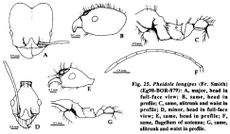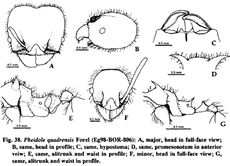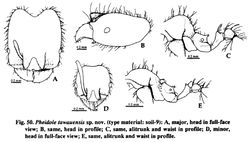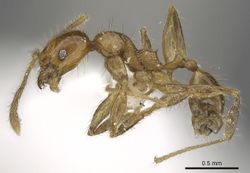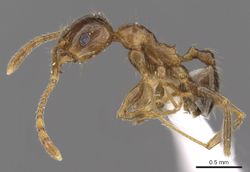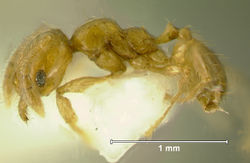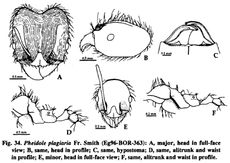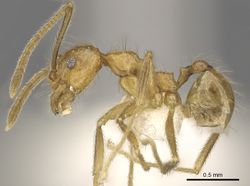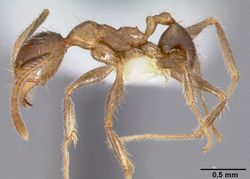Key to Pheidole minors of Borneo
This worker key is based on: Eguchi, K. 2001a. A revision of the Bornean species of the ant genus Pheidole (Insecta: Hymenoptera: Formicidae: Myrmicinae). Tropics Monograph Series. 2:1-154.
You may also be interested in
1
- Antenna with 3-segmented club . . . . . 5
- Antenna with 5-segmented club, or without conspicuous club . . . . . 2
2
return to couplet #1
- Apical five antennal segments distinctly elongate, and forming conspicuous club; posterior part of head never forming elongate neck . . . . . 3
- Antenna lacking conspicuous club; posterior part of head forming extremely elongate neck . . . . . 4
3
return to couplet #2
- Promesonotal dome relatively high; metanotal groove in profile indistinct; in profile posterior declivity of promesonotal dome and dorsum of propodeum bearing ca. 10 standing hairs in total . . . . . Pheidole quinata
- Promesonotal dome relatively low; metanotal groove in profile distinct; in profile posterior declivity of promesonotal dome and dorsum of propodeum bearing more than 20 standing hairs in total . . . . . Pheidole sabahna
4
return to couplet #2
- Propodeal spine more than 4 times as long as diameter of propodeal spiracle; body light brown to brown . . . . . Pheidole montana
- Propodeal spine 2-2.5 times as long as diameter of propodeal spiracle; body brown to dark brown . . . . . Pheidole comata or Pheidole singaporensis
5
return to couplet #1
- Promesonotum armed with a pair of long and pointed spines . . . . . 6
- Promesonotum unarmed, or armed with a pair of processes, but the processes never developed into long and pointed spines (the processes of Pheidole aristotelis well developed but truncate or blunt apically) . . . . . 10
6
return to couplet #5
- Propodeal spine elongate-triangular, ca. 1.5 times as long as diameter of propodeal spiracle; head smooth and shining . . . . . Pheidole quadricuspis
- Propodeal spine horn-like, more than 4 times as long as diameter of propodeal spiracle; head usually sculptured at least partly (in Pheidole acantha head sometimes almost smooth and shining) . . . . . 7
7
return to couplet #6
- Petiolar node in profile acute at apex; dorsum of alitrunk in profile bearing less than 10 standing hairs . . . . . Pheidole acantha
- Petiolar node in profile blunt at apex; dorsum of alitrunk in profile usually bearing more than 20 standing hairs . . . . . 8
8
return to couplet #7
- Head punctured, or largely smooth and shining and partly punctured . . . . . Pheidole spinicornis
- Head strongly reticulate . . . . . 9
9
return to couplet #8
- Body smaller (AL 1.00-1.20 mm); propodeal spine usually directed upward . . . . . Pheidole quadrensis
- Body larger (AL 1.74-1.83 mm); propodeal spine usually directed posterodorsally . . . . . Pheidole lokitae
10
return to couplet #5
- Legs from apex of femur to apex of tersus ivory-white contrasted with the remainder of femur which is dark brown . . . . . Pheidole fantasia
- Legs almost unicolored . . . . . 11
11
return to couplet #10
- Eye consisting of 5-6 ommatidia . . . . . Pheidole parvicorpus
- Eye consisting of more than 10 ommatidia . . . . . 12
12
return to couplet #11
- Head at least above subocular level distinctly sculptured; occipital carina weak or absent
dorsally on head; posterior declivity of promesonotal dome always without a distinct prominence . . . . . 13
- Head not, or only weakly, sculptured; occipital carina variable in condition; posterior declivity of promesonotal dome with, or without, a prominence . . . . . 23
13
return to couplet #12
- Dorsum of head punctured; ventrolateral face of head below subocular level smooth and shining in at least its anterior half . . . . . 14
- Dorsum of head punctured or reticulate; ventrolateral face of head below subocular level entirely punctured or reticulate; when venter of head less-sculptured (in P. retivertex and P. gombakensis), dorsum of head not punctured but largely rugoso-reticulate . . . . . 16
14
return to couplet #13
- In profile head below subocular level punctured and dull in its posterior half; petiolar node higher; eye broader . . . . . Pheidole parva
- In profile head below subocular level entirely smooth and shining; petiolar node lower; eye narrower . . . . . 15
15
return to couplet #14
- Body brown . . . . . Pheidole rugifera
- Body dark brown to blackish brown . . . . . Pheidole tenebricosa
16
return to couplet #13
- Both head and alitrunk reticulate; propodeal spine ca. 6 times as long as diameter of propodeal spiracle . . . . . Pheidole sayapensis
- At least mesopleuron and lateral face of propodeum punctured; propodeal spine usually less than 4.5 times as long as diameter of propodeal spiracle . . . . . 17
17
return to couplet #16
- Promesonotum with a pair of well-developed spines with blunt apices . . . . . Pheidole aristotelis
- Promesonotum unarmed, or only with a pair of low tubercles which never develop into distinct spines . . . . . 18
18
return to couplet #17
- Median part of clypeus distinctly punctured and dull . . . . . 19
- Median part of clypeus smooth and shining . . . . . 20
19
return to couplet #18
- Posterior declivity of promesonotal dome relatively steep; propodeal spine longer than that of P. rabo . . . . . Pheidole tjibodana
- Posterior declivity of promesonotal dome relatively gentle; propodeal spine shorter than that of P. tjibodana . . . . . Pheidole rabo
20
return to couplet #18
- Promesonotum without a pair of tubercles; propodeal spine triangular or elongate-triangular, at most twice as long as diameter of propodeal spiracle . . . . . 21
- Promesonotum with a pair of low tubercles; propodeal spine horn-like, at least 3 times as long as diameter of propodeal spiracle . . . . . 22
21
return to couplet #20
- Promesonotum smooth and shining . . . . . Pheidole gombakensis
- Lateral part of promesonotum weakly punctured . . . . . Pheidole retivertex
22
return to couplet #20
- Ventrolateral face of head below subocular level punctured . . . . . Pheidole angulicollis
- Ventrolateral face of head below subocular level reticulate . . . . . Pheidole poringensis
23
return to couplet #12
- Propodeal spine extremely long, extending over petiole . . . . . Pheidole modiglianii
- Propodeal spine sometimes long, but never extending over petiolar node . . . . . 24
24
return to couplet #23
- Alitrunk completely lacking standing hairs . . . . . Pheidole huberi
- Alitrunk bearing standing hairs . . . . . 25
25
return to couplet #24
- Declivitous face of promesonotal dome without any distinct prominence . . . . . 26
- Declivitous face of promesonotal dome with a prominence . . . . . 39
26
return to couplet #25
- Petiolar node very high; mesopleuron divided into two parts, of which lower part is more or less margined dorsally . . . . . 27
- Petiolar node not so high; mesopleuron usually not divided into upper and lower parts; if it is divided into two parts, the lower part is usually not margined dorsally . . . . . 28
27
return to couplet #26
- Longest axis of eye having 4 ommatidia; body yellowish brown . . . . . Pheidole sarawakana
- Longest axis of eye having at least 5 ommatidia; body yellowish brown to dark brown . . . . . Pheidole sauberi or Pheidole elisae
28
return to couplet #26
- Occipital carina complete . . . . . 29
- Occipital carina almost evanescent, or absent dorsally on head . . . . . 36
29
return to couplet #28
- Distance between mandibular insertion and anterior margin of eye 1.5-1.6 times as long as maximal diameter of eye . . . . . Pheidole havilandi
- Distance between mandibular insertion and anterior margin of eye at most 1.1 times as long as maximal diameter of eye . . . . . 30
30
return to couplet #28
- Metanotal groove in profile being a deep emargination . . . . . Pheidole tawauensis
- Metanotal groove shallow or indistinct . . . . . 31
31
return to couplet #30
- Petiole more than 1.7 times as long as postpetiole; anterior declivity of promesonotal dome in profile relatively steep . . . . . Pheidole lucioccipitalis
- Petiole at most 1.5 times as long as postpetiole; anterior declivity of promesonotal dome in profile relatively gentle . . . . . 32
32
return to couplet #31
- Several conspicuous rugulae running immediately above eye . . . . . Pheidole submonticola
- No conspicuous rugulae running immediately above eye . . . . . 33
33
return to couplet #32
- Upper part of mesopleuron, and lateral face of propodeum largely smooth and shining . . . . . 34
- Mesopleuron and lateral face of propodeum punctured . . . . . 35
34
return to couplet #33
- Eye small, with ca. 5 ommatidia on longest axis; head in full-face view oval . . . . . Pheidole upeneci
- Eye large, with ca. 10 ommatidia on longest axis; head in full-face view subrectangular . . . . . Pheidole manukana
35
return to couplet #33
- Body yellowish brown; promesonotum with a pair of very low tubercles dorsolaterally . . . . . Pheidole kikutai
- Body brown; promesonotum without tubercles . . . . . Pheidole megacephala
36
return to couplet #28
- Propodeal spine 3.5-4 times as long as diameter of propodeal spiracle . . . . . Pheidole deltea
- Propodeal spine at most twice as long as diameter of propodeal spiracle . . . . . 37
37
return to couplet #36
- In profile promesonotum convex, with steep posterior declivity . . . . . Pheidole hortensis or Pheidole clypeocornis
- In profile promesonotum evenly convex, or flat and low . . . . . 38
38
return to couplet #37
- Promesonotal dome in profile lower, and flatter dorsally; CI 89-95 . . . . . Pheidole merimbun or Pheidole planidorsum
- Promesonotal dome in profile higher, and convexer dorsally; CI 84-89 . . . . . Pheidole butteli
39
return to couplet #25
- Promesonotum with a pair of low tubercles . . . . . 40
- Promesonotum without a pair of tubercles . . . . . 41
40
return to couplet #39
- Distance between mandibular insertion and anterior margin of eye 1.3-1.5 times as long as maximal diameter of eye; postpetiole 2.3-2.5 times as broad as petiolar node; anterior declivity of promesonotal dome relatively steep; lateral face of promesonotum weakly punctured . . . . . Pheidole ghigii
- Distance between mandibular insertion and anterior margin of eye 0.9-1.0 times as long as maximal diameter of eye; postpetiole 2.0-2.2 times as broad as petiolar node; anterior declivity of promesonotal dome relatively gentle; lateral face of promesonotum smooth and shining . . . . . Pheidole plinii
41
return to couplet #39
- Prominence on posterior declivity of promesonotal dome, and dorsum of propodeum each bearing a pair of standing hairs . . . . . Pheidole cariniceps
- Prominence on posterior declivity of promesonotal dome, and dorsum of propodeum each bearing more than one pair of standing hairs . . . . . 42
42
return to couplet #41
- Occipital carina forming a well-developed flange, which is in full-face view narrowed at its base . . . . . Pheidole aglae
- Occipital carina sometimes forming a flange, but in full-face view not narrowed at base . . . . . 43
43
return to couplet #42
- Clypeus weakly and irregularly rugose and weakly shining . . . . . Pheidole plagiaria
- Clypeus smooth and shining . . . . . 44
44
return to couplet #43
- Large part of dorsum of head very weakly punctured; promesonotal dome in profile higher and rounder . . . . . Pheidole inornata
- Dorsum of head except the area around antennal insertion smooth over the surface; promesonotal dome in profile lower . . . . . 45
45
return to couplet #44
- Lower part of mesopleuron smooth and shining, or slightly punctured; petiole 0.9-1.0 times as long as postpetiole . . . . . Pheidole annexa
- Mesopleuron punctured; petiole at least 1.3 times as long as postpetiole . . . . . 46
46
return to couplet #45
- Head broader (CI 82-87) . . . . . Pheidole fervens
- Head narrower (CI 78-81) . . . . . Pheidole jacobsoni












